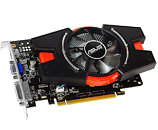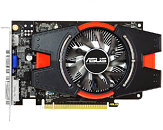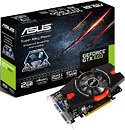Tuesday, February 12th 2013

ASUS Rolls Out a Pair of Energy Efficient GeForce GTX 650 Graphics Cards
ASUS today announced global availability of the GeForce GTX 650-E, a motherboard bus-powered DirectX 11.1 graphics card that's ideal for desktop PCs with low-wattage power supplies The GeForce GTX 650-E combines DirectX 11.1 compatibility and 28nm NVIDIA GPU technology with a mere 60W power consumption, making it a very appealing upgrade option for users looking for a high-performance graphics card at an affordable price.
The ASUS GeForce GTX 650-E offers a quick and accessible upgrade for customers interested in affordable NVIDIA 28nm GPU technology. Powered from a PCI Express slot with a modest 60W average power consumption, the ASUS GeForce GTX 650-E is an ideal choice for users looking to upgrade their PCs without investing in a new power supply, making the process much easier and less costly. Available with 1GB or 2GB GDDR5 video memory, the ASUS GeForce GTX 650-E supports medium-to-high detail in current PC games, along with smooth 1080p full HD video playback.Superior stability with Super Alloy Power
The ASUS GeForce GTX 650-E features exclusive Super Alloy Power components that reduce power loss and extend the card's lifespan by 2.5 times compared to a reference GeForce GTX 650 card. Super Alloy Power components can withstand higher temperatures and greater stress than generic power delivery designs, with the custom solid-state capacitors rated for 50,000 hours.
With fan blades shaped to restrict dust build-up and reduce the amount of debris entering the shroud, the ASUS GeForce GTX 650-E has a cooling system that maintains optimum heat dissipation for longer periods. ASUS testing shows this fan design can extend graphics card longevity by up to 25% compared to a reference GeForce GTX 650 graphics card.
Easy overclocking with GPU Tweak
The ASUS GeForce GTX 650-E delivers greater performance when used with the bundled GPU Tweak utility. A user-friendly interface offers easy adjustment of GPU and memory speeds, voltages, and fan RPM for straightforward overclocking control, and supports dedicated performance profiles to obtain the best results with different games and applications.
For more infomration, visit the product pages of the GTX650-E-1GD5 and GTX650-E-2GD5 variants.
The ASUS GeForce GTX 650-E offers a quick and accessible upgrade for customers interested in affordable NVIDIA 28nm GPU technology. Powered from a PCI Express slot with a modest 60W average power consumption, the ASUS GeForce GTX 650-E is an ideal choice for users looking to upgrade their PCs without investing in a new power supply, making the process much easier and less costly. Available with 1GB or 2GB GDDR5 video memory, the ASUS GeForce GTX 650-E supports medium-to-high detail in current PC games, along with smooth 1080p full HD video playback.Superior stability with Super Alloy Power
The ASUS GeForce GTX 650-E features exclusive Super Alloy Power components that reduce power loss and extend the card's lifespan by 2.5 times compared to a reference GeForce GTX 650 card. Super Alloy Power components can withstand higher temperatures and greater stress than generic power delivery designs, with the custom solid-state capacitors rated for 50,000 hours.
With fan blades shaped to restrict dust build-up and reduce the amount of debris entering the shroud, the ASUS GeForce GTX 650-E has a cooling system that maintains optimum heat dissipation for longer periods. ASUS testing shows this fan design can extend graphics card longevity by up to 25% compared to a reference GeForce GTX 650 graphics card.
Easy overclocking with GPU Tweak
The ASUS GeForce GTX 650-E delivers greater performance when used with the bundled GPU Tweak utility. A user-friendly interface offers easy adjustment of GPU and memory speeds, voltages, and fan RPM for straightforward overclocking control, and supports dedicated performance profiles to obtain the best results with different games and applications.
For more infomration, visit the product pages of the GTX650-E-1GD5 and GTX650-E-2GD5 variants.



6 Comments on ASUS Rolls Out a Pair of Energy Efficient GeForce GTX 650 Graphics Cards
www.techpowerup.com/gpudb/b1359/ASUS_GTX_650_2_GB.html
Edit... What is surprising is they increased the clock speed from reference 1058Mhz to 1071Mhz (1.3%); although saying the power is down some 5%! Wow and all with just a nicer power section. That’s respectable, now let's hope they don't charge "through the roof" for it, because 7750’s do seem a better all-around buy for $80-90 –AR.
Now since we're not going to see any new cards for most of 2013 it sure would be nice for reviewers' to start doing new reviews of such rivalries with the latest drivers. That would truly help see/grasp how particular market segments now compare. Like this 650-E, with the original GTX650, even say a GTX640, a regular old 7750. Perhaps one of those 900Mhz 7750 with a 6-pin, as that’s directly comparative to the original GTX650 which had a 6-Pin.
Then move up the later with other specific AIB models like say a Sapphire 7770 (1150Mhz), a few GTX560Ti’s like MSI PE, a Zotac AMP and EVGA SuperClock. Toss in a Gigabyte 7870 1GB (900Mhz), and then maybe a GTX 660 Galaxy GC 2GB (1006Mhz) . Basically stuff between $120-200. Run them as they are and then push them all with some more OC, and report such improvements in actual FPS percentage increases and power.
the result was funny: for me/us it meant that the powersection of most of the cards are not too optimized and those power-save-cards where absolute worse back then for overclocking.
please try to set the voltage on one of these cards and see if it works or the specs are tighter and it won't allow you.